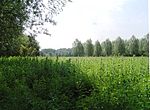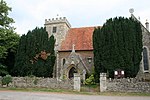Thames Path

The Thames Path is a National Trail following the River Thames from one of its sources near Kemble in Gloucestershire to the Woolwich foot tunnel, south east London. It is about 185 miles (298 km) long. A path was first proposed in 1948 but it only opened in 1996.The Thames Path's entire length can be walked, and a few parts can be cycled. Some parts of the Thames Path, particularly west of Oxford, are subject to flooding during the winter. The river is also tidal downstream from Teddington Lock and the lower parts of these paths may be underwater if there is a particularly high tide, although the Thames Barrier protects London from catastrophic flooding. The Thames Path uses the river towpath between Inglesham and Putney and available paths elsewhere. Historically, towpath traffic crossed the river using many ferries, but few of these crossings exist now and some diversion from the towpath is necessary.
Excerpt from the Wikipedia article Thames Path (License: CC BY-SA 3.0, Authors, Images).Thames Path
Thame Lane, South Oxfordshire Culham
Geographical coordinates (GPS) Address Nearby Places Show on map
Geographical coordinates (GPS)
| Latitude | Longitude |
|---|---|
| N 51.666666666667 ° | E -1.25 ° |
Address
Thame Lane
OX14 3ES South Oxfordshire, Culham
England, United Kingdom
Open on Google Maps






